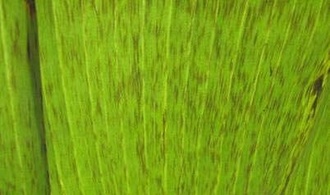The root of banana black Sigatoka disease
Written by Modified on the
Black Sigatoka, which is also called black leaf streak, is a threat to banana plants in many southern countries . It is caused by a fungus, Mycosphaerella fijiensis, and is characterized by leaf necroses that result in significant yield losses.
According to historical data, Papua New Guinea is generally assumed to be the birth place of the pathogen. However, in 1996, a team from CIRAD was the first to suggest that the origin of its recent spread worldwide may be Southeast Asia as a whole. The team has just confirmed its hypothesis.
To reach this conclusion, the researchers studied the diversity of the pathogen usinggenetic markers. They worked on 730 individuals from 37 countries covering thepathogen's distribution zone. "We expected to see a high density in PapuaNew Guinea alone ", Jean Carlier, a plant pathologist at CIRAD andco-author of the study, explains. "But this was also the case for several other places in Southeast Asia ." These results confirm the existence inM. fijiens is of an extensive diversity centre covering the whole of SoutheastAsia. They also strongly suggest that the disease spread a long time ago through this zone, which includes the birthplace of the pathogen : "the pathogen may have appeared in Papua New Guinea, but it could just as well have appeared else where in Southeast Asia ", the researcher stresses.
The study also revealed the routes taken by M. fijiensis as it spread world wide , inparticular with two different introduction scenarios in Africa and Latin America. Whereas a small number of very genetically similar individuals were apparently the origin of the invasion of Africa, probably as a result of a single introduction, Latin America appears to have been invaded by populations resulting from a mixture of sources. According to historical data, the mix apparently happened in Honduras. However, in both cases, the introduction ledto the rapid spread of the disease.
This result raises many questions. The researchers suspect that human activity played amajor role in this global invasion. They also suppose that the pathogen had already adapted during the domestication and development of banana growing onthe fringes of its original habitat, before it spread. South east Asia is indeed the birth place of the pathogen, but also of banana and its domestication.
These results serve to explain how this type of disease spreads and causes epidemics world wide. They also show the necessity of tightening quarantine measures to restrict the spread by man. Lastly, they high light the importance of improving our knowledge of host populations and pathogens in their common diversity centre. This knowledge is required in order to determine how the pathogen adapts to its host and environment. It will also be of use in identifying with in the region of origin the zones in which the host and pathogenco-evolved, which are potential sources of host resistance, genetic resources that are required to create new disease-resistant varieties.


